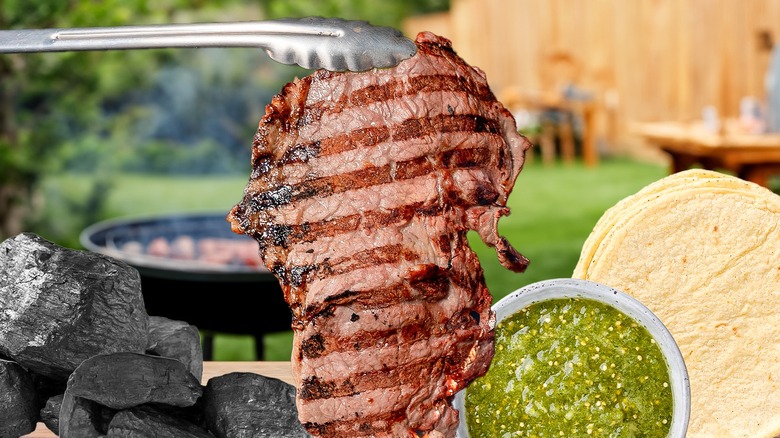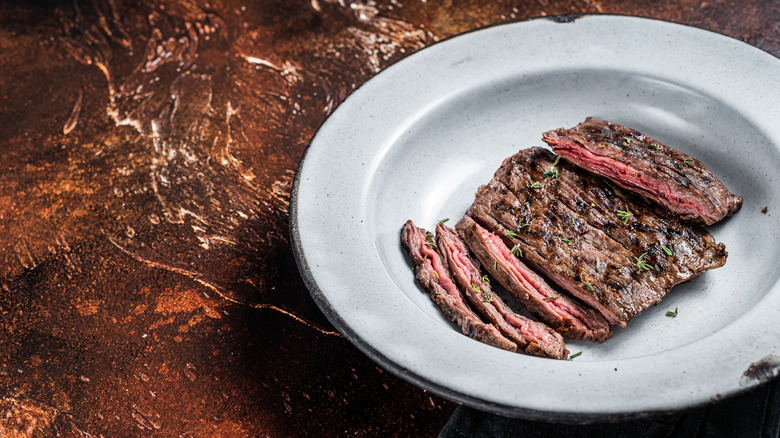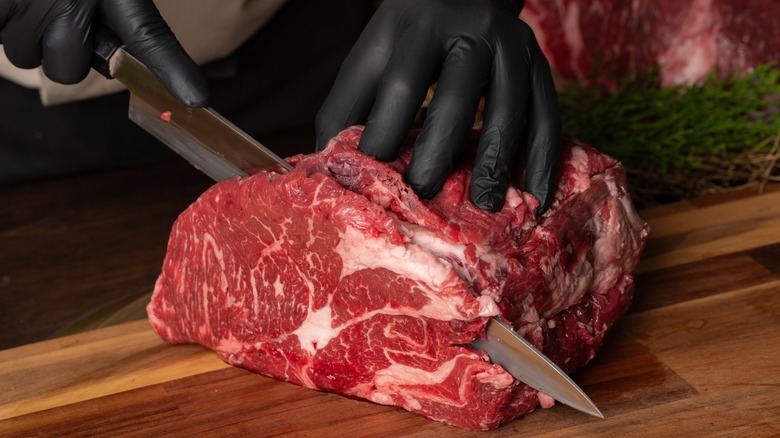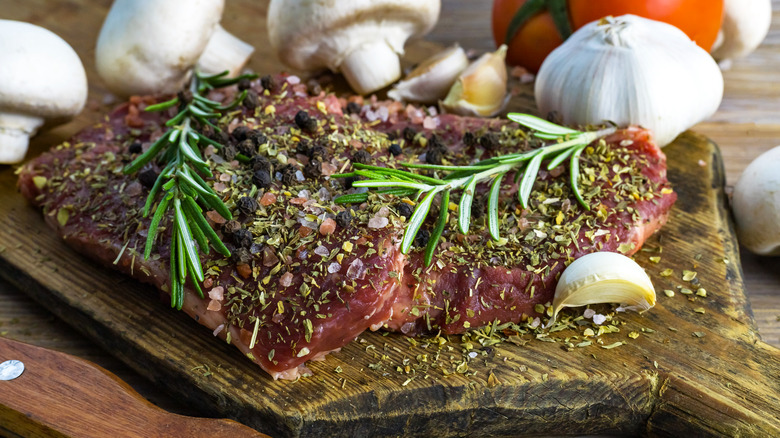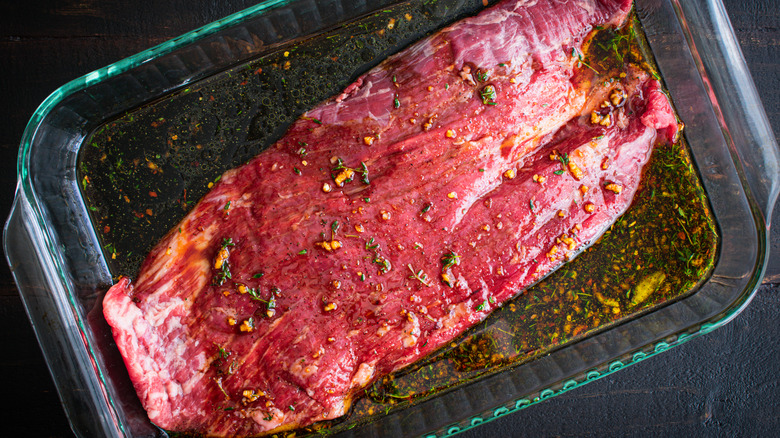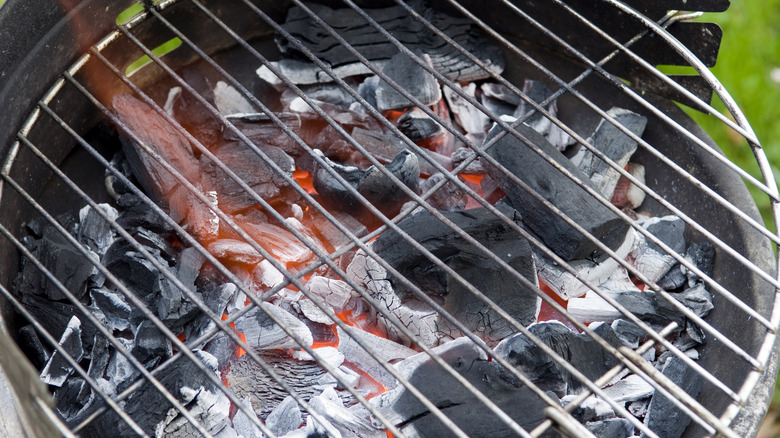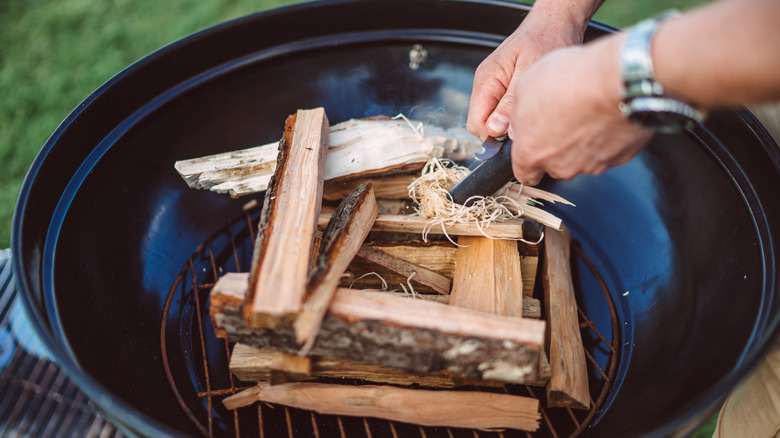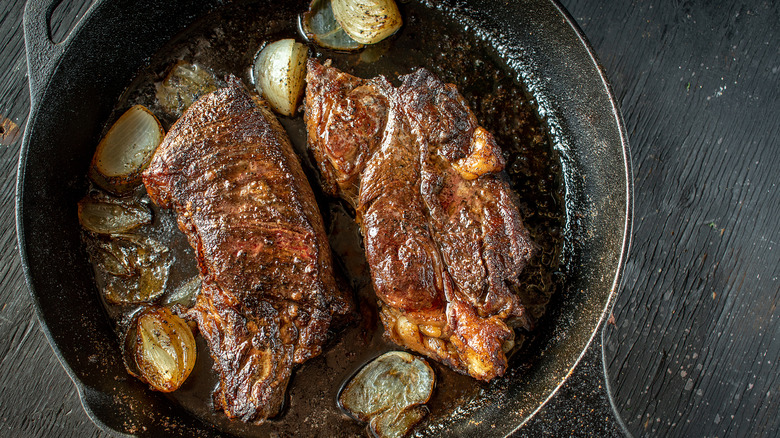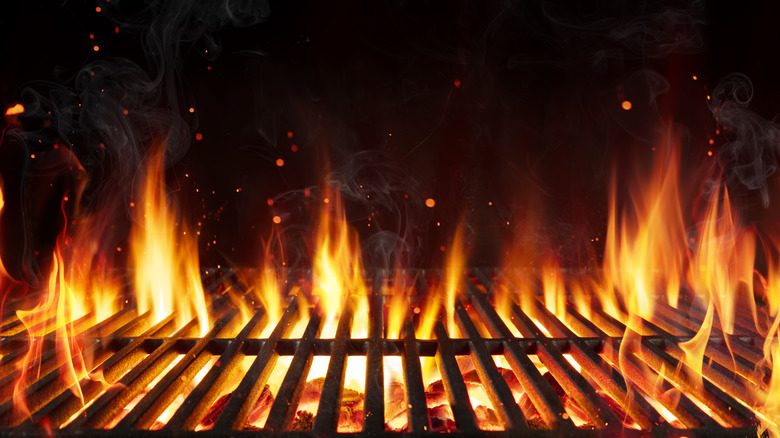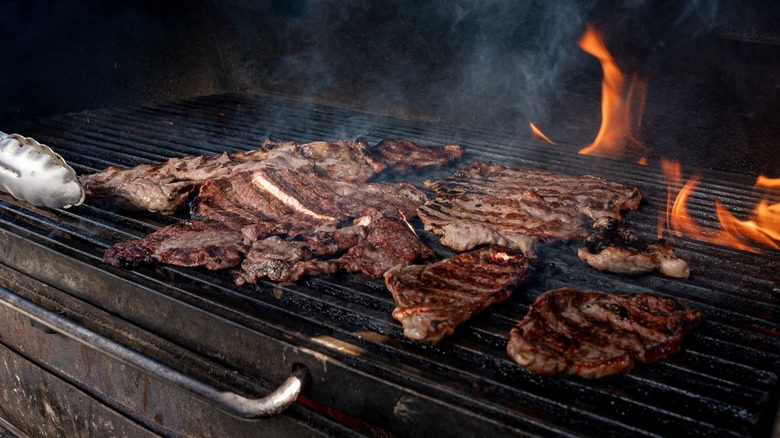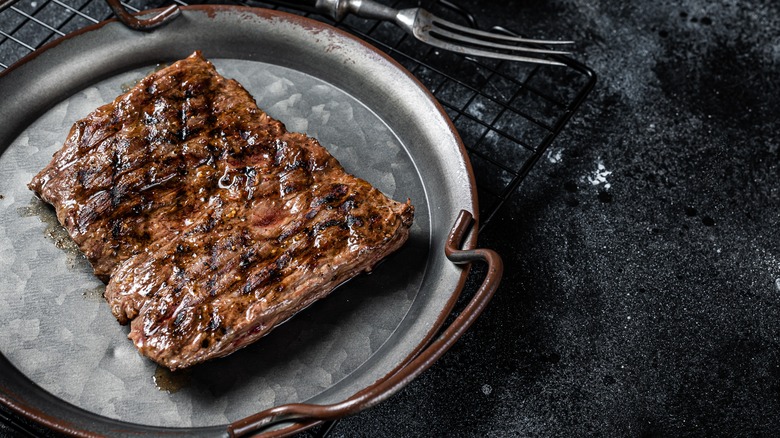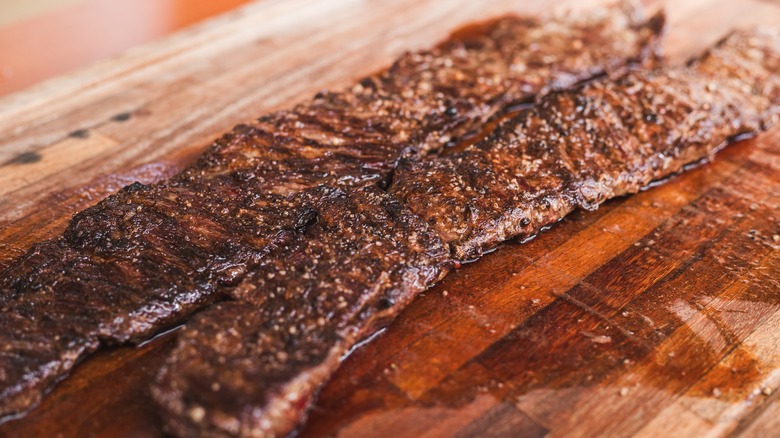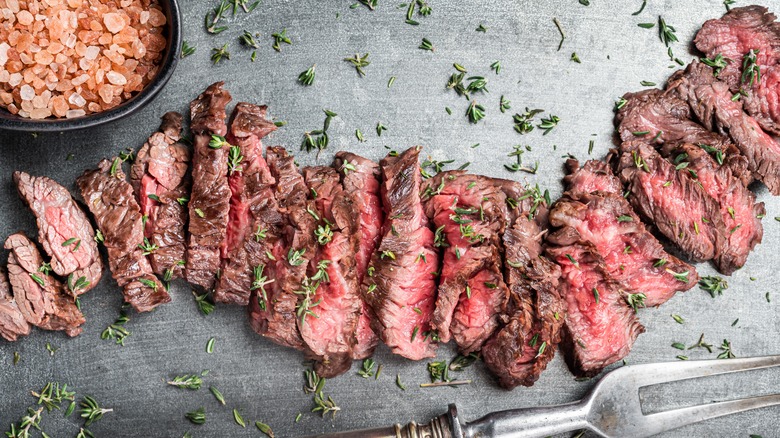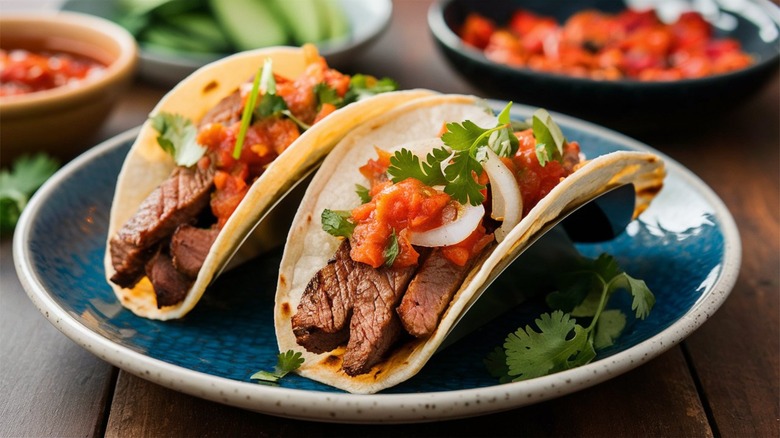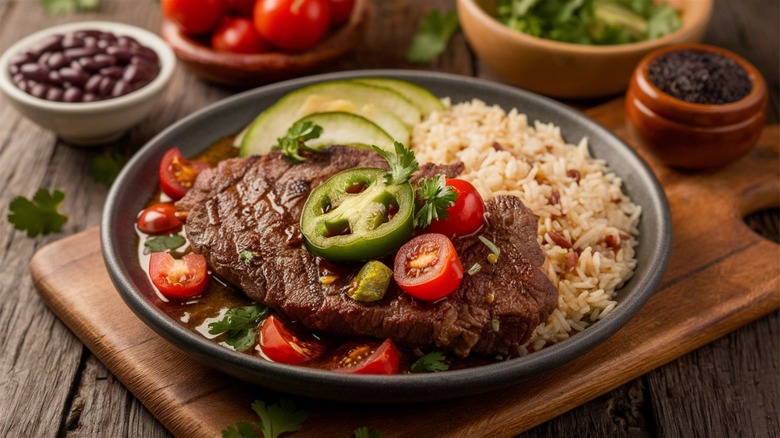14 Chef-Approved Tips For Perfect Carne Asada
We may receive a commission on purchases made from links.
It doesn't get more Mexican than carne asada. The term translates to "grilled meat," although people often use it to refer specifically to grilled steak. In Mexico, carne asada can also be a gathering similar to a backyard barbecue where friends and family get together to enjoy grilled meats and cold beers. There's nothing overly fancy about carne asada the dish (or the gathering for that matter). However, there are some ways that you can take this Mexican meal to the next level.
If you watch carne asada being made, it looks pretty straightforward. Take a steak, throw it on the grill, and you're good to go. What you don't see though is the preparation that goes into selecting and seasoning the meat. It also requires certain knowledge to get that beef just right so that it's juicy, tender, and full of flavor.
To unlock the secrets of making the perfect carne asada, we spoke to chefs who specialize in Mexican cuisine. We asked them how they make their carne asada, and they advised us on everything from choosing the best steak cuts to key marinade ingredients and top grilling techniques. These are their expert tips for cooking the tastiest and most authentic carne asada.
Arrachera (skirt steak) is king
When we asked the experts which cut of steak is best for carne asada, nearly every chef recommended one particular cut as their top choice. David Figueroa, chef and co-founder of Melinda's Foods, said, "There's no secret here — it's skirt steak all day, every day. Flank steak is another option, but it tends to be less marbled and a bit more 'livery' in flavor. Skirt steak, on the other hand, brings that ultimate beefy flavor we all crave."
Also known as arrachera, skirt steak is a cut that comes from the chest and abdomen area of the cow below the ribs. It's a long, flat cut that has a distinctive grain running through it. There are several reasons skirt steak works so well for carne asada. First, the thinness of the cut and the thick grain are perfect for soaking up marinade. Skirt steak is also rich in flavor and has a decent amount of fat in it that keeps it nice and juicy when it's grilled properly. Best of all, it's a flavorful steak cut that won't break the bank.
Your butcher can help you find alternative cuts if you can't find skirt steak
Can't find skirt steak at your local grocery store or butcher shop? Your butcher may be able to help you find other cuts that are similar in texture and flavor. For example, flank steak is another cut that comes from the abdominal area of the cow. The main difference between skirt steak and flank steak is the size — flank steak is typically shorter and thicker than skirt steak. Wes Avila, chef of MXO Mexican Steakhouse in West Hollywood, told Chowhound, "When cooked correctly, flank steak is flavorful and tender." Like skirt steak, flank steak can taste great when marinated and grilled over high heat.
"Sirloin is also a great option for a more budget-friendly choice," said Avila. The sirloin comes from an area of the cow close to the rear legs. Sirloin is typically divided into the top sirloin and the bottom sirloin. Your butcher may recommend flap steak, which comes from the bottom sirloin. Also called bavette, this is another thin cut with a rich, beefy flavor that cooks nicely over high heat on a grill or in a cast iron pan.
A good marinade is the key to tender, juicy meat
A marinade is a great way to add flavor to your carne asada and help tenderize the meat. Acidic elements like citrus juice and vinegar can help break down the fibers in the meat and make it more tender. Oil imparts moisture, and herbs and spices can add complexity. When it comes to carne asada, many chefs create marinades using classic Mexican ingredients. For example, Yvette Marquez-Sharpnack of Muy Bueno said, "My marinade includes butter, tequila, lemon and lime juice, thyme, serrano chilies, garlic, cilantro, and onion."
Wes Avila also gave us a few tips for making a flavorful marinade. He said, "A classic carne asada marinade includes lime juice, orange juice, garlic, cilantro, cumin, chili powder, and soy sauce or Worcestershire sauce. Some recipes also add jalapeños or other spices for a kick." Don't be afraid to experiment with different ingredients. For example, you could swap the citrus juice for vinegar or include honey or brown sugar for a touch of sweetness and to enhance the caramelization. Avila also recommends using fresh ingredients for the best flavor.
Marination time matters
Once you've whipped up your marinade and slathered your steak with those flavorful liquids and spices, you need to let the meat sit submerged in the marinade long enough to soak up the flavors and let the acidic ingredients work their magic. Acids like citrus juice and vinegar break down proteins in the meat through a process called denaturation. This has two effects: it softens the meat and makes the structure looser, which allows the flavors in the marinade to absorb into the meat better.
Although there is no hard and fast rule for exactly how long to marinate your steak for carne asada, many chefs recommend at least an hour. Wes Avila told us, "Ideally, the steak should be marinated for at least one to four hours. However, marinating overnight can enhance the flavor even more without affecting the texture too negatively." The only thing to be careful about is marinating your meat too long. Anything over 24 hours can break down the proteins too much, resulting in mushy or grainy meat.
Charcoal is a good way to go
Many chefs will tell you that the only way to cook carne asada is on a grill over open flames and that charcoal trumps gas every time. That's because charcoal imparts a beautiful smokiness to the meat that you just won't get on a gas grill. It may be messier to grill with charcoal than gas, but many say it's worth it for the elevated flavors and aromas.
Flavor isn't the only thing that charcoal brings to the table. It can also give you the ideal blast of high heat you need for properly cooked carne asada. David Figueroa told us, "A good gas grill can work, but they often have cool spots. Carne asada needs even heat across the length of the steak, and charcoal delivers that sear better than anything." One of the biggest mistakes people make grilling with charcoal is not letting the coals heat up properly. You want to make sure that the coals are white hot nearly all the way through and emitting a substantial amount of heat before throwing the meat on the grill.
Wood can impart amazing flavors
Charcoal is great for grilling, but it can also be messy. If you want to avoid the soot, consider using wood as your fuel source. Wood is all-natural, easy to light, and produces a lot of heat. In fact, wood can burn hotter than charcoal, which is exactly what you want when you're quick-searing carne asada. Moreover, the smoke from the wood can infuse the meat with wonderful flavors. Wes Avila told us, "Nothing beats cooking over a wood fire, specifically mesquite for optimal flavor."
One of the great things about grilling with wood is that different types of wood offer different flavors. As Avila mentioned, mesquite is one of the best types of wood for grilling carne asada because it can provide bold, earthy flavors. Hickory is another popular wood for grilling because it gives off a rich flavor that many say is reminiscent of bacon. Wood from fruit trees can add a slight touch of sweetness, while oak imparts a milder, more subtle smoky flavor. Just be sure to use firewood that is fully dried so that it burns properly and gives the best flavor.
No grill? Use a cast iron pan
Sadly, many of us don't have access to a grill. Yvette Marquez-Sharpnack told Chowhound that's not a problem. "Simply opt for a cast iron grill pan and do the cooking on your stovetop," she said. There are several reasons a cast iron pan is important for a good seared steak. For one, cast iron distributes heat evenly across the pan and holds the heat well, even after the pan is removed from the heat source. In addition, a well-seasoned pan will prevent the steak from sticking.
When we talk about seasoning a cast iron pan, we're not talking about adding spices. Cast iron seasoning is a layer of oil that is baked into the pan to give it a smooth, non-stick surface. The seasoning process is pretty simple — just coat a clean, rust-free pan with a thin layer of oil and bake it in the oven.
Once your cast-iron pan is seasoned nicely, you can start prepping your carne asada. Marquez-Sharpnack recommended letting the steak come to room temperature before cooking it. While the meat is coming to temperature, preheat the cast iron pan until screaming hot. The hot pan will help give your meat a beautiful sear.
Blazing hot heat is essential
You may have noticed a recurring theme here, and that's that high heat is essential for carne asada. According to David Figueroa, "If your coals (or grill) aren't as hot as they can get, you're missing out on that perfect char. You need high heat for the magic to happen." Because cuts like skirt steak and flank steak are thin, they cook quickly, not giving you much time to get a good crust. That's where high heat comes into play.
The reason steak develops a lovely brown, charred crust is due to something called the Maillard reaction. This is a chemical process where the proteins and sugars in the meat respond to high heat and the meat changes color from red to brown. If done right, you should also get an appealing crispy texture.
Figueroa says the key to kicking off the Maillard reaction is serious heat. He said, "Get that fire blazing and lower your cooking grate close to the coals. For an extra charred finish, I sometimes dust off the coals and throw the meat directly onto them — one to two minutes per side, depending on thickness. You're aiming for that perfect medium rare."
Don't move your steak around while it's cooking
Whether you're using a grill or a cast-iron pan, many chefs say you shouldn't move the steak around too much. Wes Avila advised, "Avoid flipping it too often, as this can prevent a good sear." This theory makes sense when you think of how the Maillard reaction works. You need that high heat to transform the proteins and sugars into a nice crust. If you don't give the heat time to do its job, how can you expect the reaction to fully take place?
The only problem that some people have with not flipping the steak often is that it may not cook evenly. Fortunately, there are some ways around this. First, you want to make sure that the steak is at room temperature so the meat is more relaxed. If cold meat comes into contact with a hot surface, it can cause the fibers in the meat to seize up, creating uneven surfaces. Drying off your steak can also help. Moisture on the surface of the meat can create steam that stops the crust from forming in some spots.
Beware of overcooking your meat
Ask any chef what the biggest steak mistake is and most will say overcooking the meat. This is especially true for carne asada. As we mentioned earlier, thin cuts like flank and skirt steak tend to cook very quickly. Leave them on the grill for too long and you could end up with tough, dried-out meat. No matter how fiery your salsa is or how fresh your pico de gallo tastes, no amount of sauce will cover up chewy, overcooked carne asada.
Wes Avila told us the best way to prevent overcooked meat is to use a meat thermometer. "You want to aim for a medium-rare (about 130 F)," he said. Remember that the steak will continue to cook after you take it off the grill. In general, you can expect the meat to increase about five to 10 degrees more. Therefore, you should take it off the heat when the temperature is about 125 F on the grill. If you prefer your meat rare, medium, or well-done, you can use this handy steak temperature cheat sheet to gauge the best temperature to cook your meat.
Let your meat rest before cutting it
Overcooking isn't the only reason your carne asada may be dried out. Another major mistake is cutting into the meat right off the grill. Meat needs to rest after it's done cooking. There are two reasons for this. One is that while it's cooking, the muscle fibers tighten up and the juices rise to the surface of the meat. Resting allows the meat to relax and the juices to spread back into the meat. In addition, meat continues to cook after it comes off the heat. If you cut into it right away, not only will you lose some of those juices, but you may also end up with underdone meat.
Because carne asada is typically made with thinner cuts of steak, five to 10 minutes should be enough time to let the juices redistribute and the meat to continue cooking all the way through. In the words of the late, great Anthony Bourdain from a video posted on the "No Reservations" Facebook page, "Don't wrap it in foil, don't cover it, don't poke it, don't prod it. Don't even look at it. Just let it sit there. Leave it alone and you will be rewarded."
Slice your steak against the grain
So you've cooked your meat to perfection and let it rest for an appropriate time to let the juices redistribute and the meat finish cooking. Finally, it's time to slice into it and serve it up. Here's another opportunity where you can elevate the meat even more. According to the experts we spoke to, you should always slice the meat against the grain. Wes Avila told us, "This shortens the muscle fibers and makes each bite more tender."
The grain in a piece of meat refers to the small lines that run throughout the meat. These are the muscle fibers and they typically run vertically or horizontally along a cut of steak. When slicing the steak, you want to cut perpendicular to the muscle fibers to help break them up. This will make the steak less chewy. Fortunately, cuts like skirt steak and flank steak have pretty thick grains, which makes it easy to see which direction the muscle fibers are going and which direction you need to slice.
You can't have carne asada without tortillas and salsa
You can eat carne asada on its own, but many say the dish isn't complete without tortillas and salsa. The traditional way to eat carne asada is to take your slices of meat and put them in a tortilla with a spoonful or two of salsa on top. Fold it up like a taco and you're good to go.
The next question is corn or flour tortillas. Some people will tell you corn is the only way to go. After all, corn is a cornerstone of Mexican cuisine and corn tortillas are the preferred vehicle for tacos throughout the country. That's not to say flour tortillas don't have a place, though. It's common to find flour tortillas in many northern Mexican states. At the end of the day, it all comes down to your personal preference and what's available to you.
While you may be limited in your choice of tortillas, the sky's the limit when it comes to salsas. You can go with red, green, fiery, or mild salsa. Yvette Marquez-Sharpnack said, "Some of my favorite toppings include salsa verde, tomatillo avocado salsa, and chile de arbol salsa."
Simple, fresh sides are best
Besides tortillas and salsa, there are numerous side dishes and toppings you can serve with carne asada. David Figueroa offered one piece of advice when it comes to the sides. He said, "Keep it simple and fresh — let the carne asada shine!" Remember that the bold, beefy flavors of the carne asada are the main highlight of the meal, so you want to go with bright ingredients that complement that richness and earthiness without overpowering it.
Figueroa told us he likes to serve his carne asada with simple dishes like stewed beans, white rice, avocado, and a tangy salad with some fried plantains. Yvette Marquez-Sharpnack likes to add borracho beans ("drunken" beans cooked with beer and bacon), cilantro lime rice, and grilled green onions to her spread. Other side dishes and toppings could include guacamole, pico de gallo, queso fresco, chopped onions, cilantro, lime wedges, and grilled veggies. Lastly, carne asada always tastes better with cold beer, of course.
